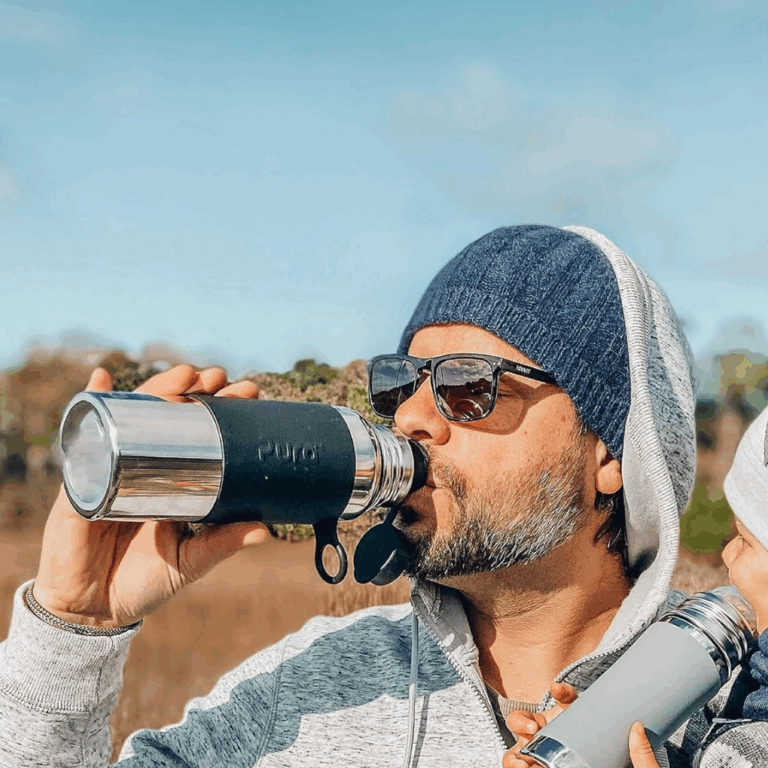
Key Takeaways
- Reverse osmosis systems remove up to 99% of PFAS, heavy metals, and microplastics.
- Top picks for 2025 include AquaTru, Waterdrop, and APEC—each proven for clean taste and efficiency.
- RO filters save money over bottled water and prevent thousands of plastic bottles from ending up in landfills.
I never used to think twice about the water coming from my fridge—until one day it started tasting off. After a bit of research (and a deep dive into what’s hiding in those lines), I learned that fridge filters barely touch what really matters: PFAS, microplastics, and even traces of pharmaceuticals.
Here’s the part that really shocked me: a global investigation by Orb Media found that 83% of tap-water samples from more than a dozen countries contained plastic particles. Microplastics have infiltrated our most basic resource, tap water, and they’re small enough to pass right through most standard filters.
That’s when I switched to a reverse osmosis (RO) system, and the difference was immediate. The water is crisp, pure, and actually tastes clean. My family and I drink more water now, and knowing it’s filtered at the molecular level gives me real peace of mind.
What Reverse Osmosis Is and How Does It Works
Reverse osmosis (often called RO) is a type of water filtration that uses pressure to push tap water through a semi-permeable membrane, a layer so fine that it allows only water molecules to pass. Everything larger — like PFAS, microplastics, lead, and even pharmaceutical residues — is left behind.
Think of it as giving your water a deep molecular cleanse. The result is crisp, pure-tasting water that’s free from most contaminants found in typical tap or bottled water.
RO systems usually include several stages of filtration: a sediment filter to catch dirt and rust, carbon filters to remove chlorine and odors, and an RO membrane that blocks microscopic particles. Some models even include a remineralization stage to restore calcium and magnesium, improving taste and pH balance.
Learn More: Does Reverse Osmosis Remove Microplastics? See how RO filtration compares to other water purification methods and which one removes the most contaminants. Read more →Why Reverse Osmosis? The Real Benefits You Need to Know
Let’s get straight to what matters most: what reverse osmosis systems remove from your water. Unlike basic pitcher filters that mainly tackle chlorine taste, RO systems use a semi-permeable membrane that blocks contaminants at the molecular level.
- PFAS “Forever Chemicals”: These are the chemicals that don’t break down naturally and accumulate in your body over time. Quality RO systems can remove up to 99% of PFAS compounds. To put this in perspective, if your tap water has 50 ppt (parts per trillion) of PFAS, a sound RO system brings that down to less than one ppt.
- Pharmaceuticals and Hormones: Yes, trace amounts of medications, birth control hormones, and antibiotics end up in municipal water supplies. Standard water treatment plants aren’t designed to remove these. I was genuinely surprised to learn this, but RO membranes can filter out most pharmaceutical residues that pass through traditional treatment processes.
- Microplastics: These tiny plastic particles are everywhere now, including your tap water. Studies show the average person consumes about 5 grams of plastic weekly (that’s like eating a credit card). RO filtration physically blocks these particles since they’re larger than water molecules.
- Heavy Metals and Chemicals: Lead, mercury, arsenic, chlorine, fluoride, and volatile organic compounds (VOCs) are all significantly reduced. You’ll see this reflected in TDS (Total Dissolved Solids) readings. My tap water measured around 240 TDS, while my RO water consistently reads under 20 TDS.
Health Benefits You’ll Actually Notice
When you switch to reverse osmosis (RO) water, the first thing you notice is the taste—it’s clean, crisp, and chemical-free. But the real difference goes deeper than flavor. Many people say they feel better overall, and there’s solid evidence to back it up.
💧 Fewer Toxins, Less Stress on Your Body
Every sip of RO-filtered water helps reduce your exposure to PFAS, chlorine, microplastics, and heavy metals—contaminants linked to everything from hormone disruption to digestive issues. Drinking water that’s free from those chemicals gives your body fewer toxins to process every day, helping your liver, kidneys, and immune system do their jobs more efficiently.
🌿 Better Digestion and Hydration
Without chlorine or dissolved solids getting in the way, RO water is absorbed more easily by your body. People often notice less bloating and smoother digestion, especially if they’re sensitive to additives in tap water. You may even find it easier to stay hydrated because the water tastes so pure that you naturally drink more.
👩🦰 Skin and Hair Glow-Up
While you’re not showering in RO water (unless you have a whole-house system), what you drink still shows up on your skin. Hydrated cells and less chemical exposure can lead to softer skin, fewer breakouts, and less irritation—especially for those prone to dryness or sensitivity. Some users even notice their hair feeling shinier and stronger after a few weeks.
While reverse osmosis systems offer impressive benefits, it’s essential to understand their limitations before making a purchase decision.
cons
Downside of Reserve Osmosis Systems
- Water Waste: Traditional systems produce wastewater during the filtration process, although newer models are more efficient. For the AquaTru Carafe, I typically discard a couple of cups of wastewater per filtration cycle.
- Mineral Removal: Thorough filtration removes both beneficial minerals and contaminants.
- Initial Investment: Upfront costs range from $200 to $1,400 (unless you do the entire house) plus potential installation expenses.
- Counter Space: Countertop systems require dedicated space and may not be suitable for all kitchen layouts.
- Installation Requirements: Under-sink systems may require professional installation or plumbing knowledge.
Are Reverse Osmosis Systems Cost Effective?
Yes, RO systems are highly cost-effective compared to bottled water. Most systems pay for themselves within 6 to 18 months and continue to provide significant long-term savings.
Long-term Value vs. Bottled Water
This is where the numbers get interesting. Consider a family of four spending $20 a week on bottled water – that’s over $1,000 each year. Meanwhile, a decent countertop RO system costs $300-600 upfront, followed by an annual cost of $100-150 for new filters.
💰 5-Year Cost Comparison:
- Bottled water: $5,200+
- RO system: $1,200-1,500 (including initial purchase and filter replacements)
That’s real money back in your pocket, plus you eliminate hundreds of plastic bottles from ending up in landfills or oceans.
Convenience Factor: No more lugging heavy water cases from the store. No more running out of clean water at inconvenient times. No more plastic bottles cluttering your fridge. You get unlimited clean water on demand.
Environmental Impact: The average American uses approximately 167 plastic water bottles per year. Multiply that by your family size, and you’re looking at eliminating 500+ bottles per year for a family of three. Over five years, that’s more than 2,500 bottles that don’t end up in waste streams.
Water Security: With increasing concerns about municipal water quality and infrastructure, having your filtration system provides independence from external water supply issues. When there’s a boil water advisory or contamination scare, you’re already protected.
Performance Specifications That Matter
When you start comparing reverse osmosis systems, you’ll see a lot of numbers and fancy terms thrown around. Some sound impressive, but most of them don’t really change your day-to-day experience.
So instead of getting lost in the details, focus on the three things that actually matter:
- How fast does the system give you clean water
- How much water is wasted in the process
- What contaminants does it remove
💧 Flow Rate and Daily Capacity
Flow rate is just a fancy way of saying how quickly you get your water. It’s usually measured in gallons per day (GPD) or gallons per minute (GPM).
Countertop systems like the AquaTru make about 0.04 GPM, which means it takes around 30–45 seconds to fill a cup. Under-sink tankless models, like the Waterdrop G3P800, are much faster—they can produce up to 800 GPD, filling a cup in just five seconds.
✨ If you have a family of four or more, look for a system with at least 400 GPD so no one has to wait for their water during busy times.
♻️ 3:1 Efficiency Ratio and Water Waste
Older reverse osmosis systems used to waste a lot of water, sometimes six cups wasted for every one cup cleaned. Thankfully, that’s changed.
Modern systems are far more efficient, usually around 2:1 or 3:1. That means for every three cups of filtered water, only one cup is wasted. For example, the Waterdrop G3P800 has a 3:1 ratio, which can save a family that uses five gallons of filtered water each day more than 1,800 gallons of water every year.
🔬 Contaminant Removal Capabilities
Here’s where quality really counts. Not all systems remove the same pollutants, so look for certifications that prove the filters work as promised.
- To remove PFAS (forever chemicals), check for NSF 53 or P473 certification, which ensures a 95–99% reduction.
- For heavy metals like lead, arsenic, or chromium, look for NSF 58 certification.
- The best systems can remove over 1,000 contaminants, including microplastics, pharmaceuticals, and volatile organic compounds (VOCs).
✨tips
How to Reduce RO Water Waste
- Select an Efficient System: Look for models with low waste ratios of 2:1 or better. Newer systems are significantly more efficient than older designs.
- Consider a Permeate Pump: These devices improve system efficiency without using electricity, helping reduce water usage while extending filter life.
- Maintain Proper Water Pressure: Systems work most efficiently at around 60 psi. Low pressure forces the system to work harder and use more water.
- Repurpose Reject Water: The “waste” water is clean—it just contains the minerals that were filtered out. Use it for watering plants, cleaning, or other non-drinking purposes rather than letting it go down the drain.
What About Remineralization?
One concern I kept reading about during my research was that reverse osmosis water is “too pure” and strips away beneficial minerals. After months of drinking RO water and digging into the science, here’s the reality about whether you need to add minerals back.
The Mineral Loss Reality
Reverse osmosis removes both harmful contaminants and beneficial minerals like calcium and magnesium. Testing shows RO can reduce these minerals by 90-97%. That sounds dramatic, but the USDA found that tap water only provides about 6% of your daily calcium and 5% of magnesium needs. Most essential minerals come from food, not water.
When Remineralization Makes Sense
Taste Preferences: Some people find RO water tastes “flat” compared to mineral-rich tap water. If you’re used to harder water, remineralization filters or mineral drops can restore a more familiar flavor.
pH Adjustment: RO water is slightly acidic (around 6.0-6.5). While your body handles this fine, some prefer alkaline water. Remineralization often brings pH back to 7.0-8.5.
Cooking Needs: Professional chefs sometimes prefer mineral content for bread making, coffee extraction, or tea brewing.
Your Options
Built-in Filters: Systems like the AquaTru Alkaline include remineralization cartridges that add back calcium and magnesium while adjusting pH.
Mineral Drops: Products like Trace Minerals let you add minerals to individual glasses. More economical than replacement filters and gives you control over mineral content.
Detailed Product Comparisons and Performance Analysis
After months of testing my own AquaTru system and researching dozens of others, I’ve narrowed down the best reverse osmosis systems across different categories and budgets. These aren’t just the systems with the flashiest marketing, they’re the ones that actually deliver clean water consistently with reasonable maintenance costs.
Before we dive in, here’s how I evaluated these systems: I prioritized contaminant removal performance (especially PFAS and microplastics), real-world efficiency ratios, filter replacement costs over time, and user feedback from people who’ve owned these systems for years, not just weeks.
| Feature | Countertop Systems (AquaTru, AlcaPure) | Under-Sink Systems (Waterdrop, APEC) | Whole-House Systems (US Water Defender) |
|---|---|---|---|
| Contaminant Removal | Removes 95–99% of PFAS, microplastics, and heavy metals; best for drinking water only. | Removes 1,000+ contaminants including PFAS, VOCs, lead, fluoride, and pharmaceuticals. | Filters entire home; removes 99% of total dissolved solids (TDS) plus UV disinfection. |
| Filtration Speed | ~1 cup in 30–60 sec (0.04 GPM) | 1 cup in 2–5 sec (400–1600 GPD capacity) | High-capacity continuous flow (140–250 gal storage) |
| Installation & Space | Plug-and-play setup; sits on counter like a coffee maker. | Under-sink installation, saves space; may require drilling faucet hole. | Professional installation in utility area; requires plumbing and space. |
| Efficiency / Waste Ratio | ~4:1 waste ratio (typical for countertop) | Up to 3:1 or better with new tankless tech | 1.25:1 ratio (≈ 80% efficiency) |
| Ideal For | Renters, small families, or apartments needing quick setup. | Families who use 3–6 gal/day and want fast, continuous clean water. | Large households or anyone wanting purified water at every tap. |
What’s the Difference Between Countertop and Under-sink Systems?
Countertop systems offer portability and easy setup by connecting to your existing faucet. Under-sink plumbing systems provide a dedicated filtered water faucet and higher capacity, but require permanent installation.
Countertop systems require zero installation; simply plug them into a standard outlet and connect to your faucet using the included adapters. Setup takes just 10 minutes compared to 1-3 hours for under-sink installations. While these systems utilize counter space and offer smaller storage capacity, they’re perfect for renters or anyone seeking immediate filtered water without requiring permanent modifications.
Best Overall Performance: AquaTru Classic Countertop System
$375 – 475

Setup and Maintenance:
True plug-and-play installation in under 10 minutes, no plumbing required. Twist-lock filter system allows 30-second replacement per filter.
Filters:
– Pre-carbon: 6 months / $30
– RO membrane: 24 months / $70
– VOC filter: 12 months / $35
Estimated annual maintenance cost: $80–100 based on usage.
Efficiency Ratio:
4:1 waste-to-pure water ratio. Typical for countertop RO systems, though higher than tankless and zero-waste alternatives.
Storage Capacity:
Filtered water tank: ~0.75 gallons (96 oz); Source water tank: ~1 gallon (128 oz). The filtered tank is removable and sized to fit standard refrigerators for storing cold water.
- Certifications: IAPMO certified to NSF Standards 42, 53, 58, 401, and NSF 372 for lead-free design
- User Feedback: Customers consistently praise the “amazing taste” and report feeling better after switching from tap water. Many mention it works well with healthy water and appreciate the fast filtration speed. Some users note that the digital display helps track filter life accurately.
Personal Review
I own the AquaTru carafe model and have been pleased with the clean-tasting water and its simple operation.
The primary drawback is the noise level generated during the filtration process, which is typical of reverse osmosis systems.
Given how much water my son and I consume daily, I now realize the under-sink version would have been a better choice for our household’s needs.

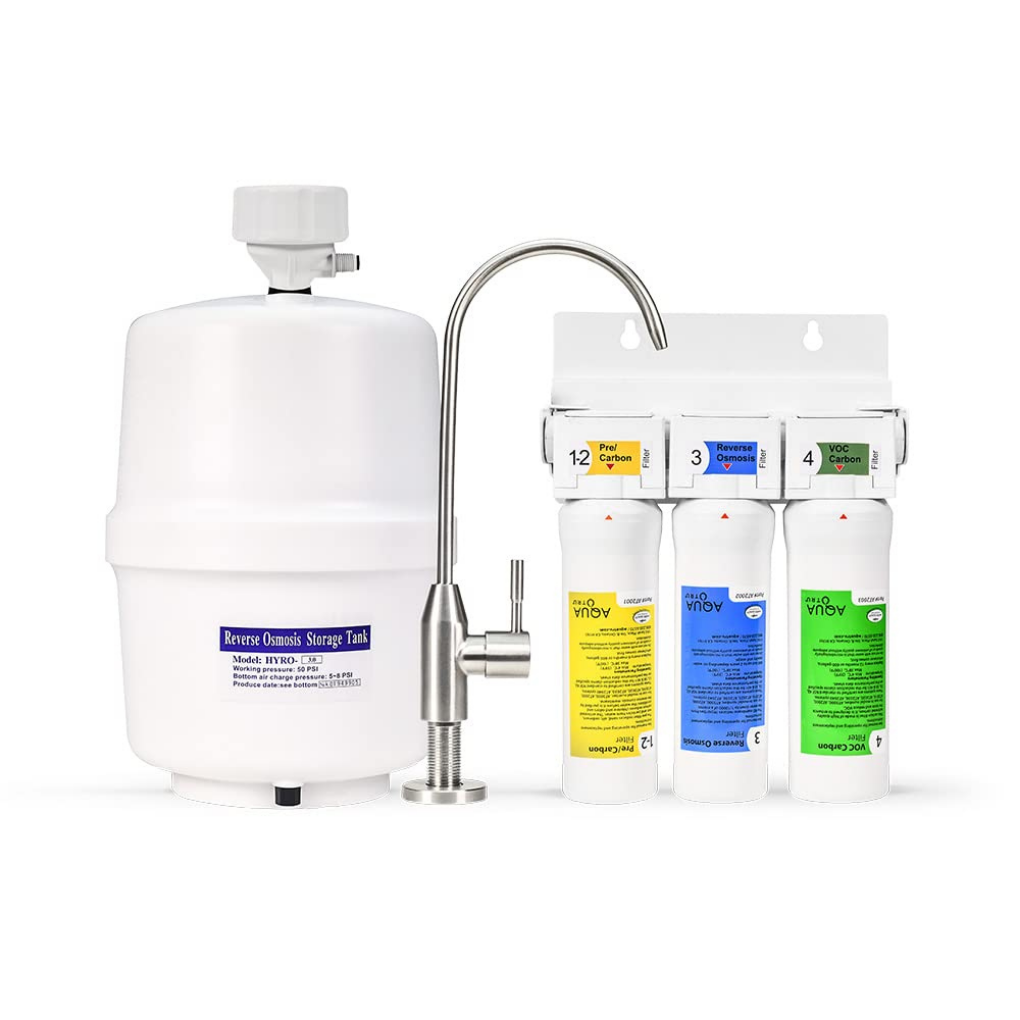

Best High-Capacity Performance: Waterdrop
$200-1,600
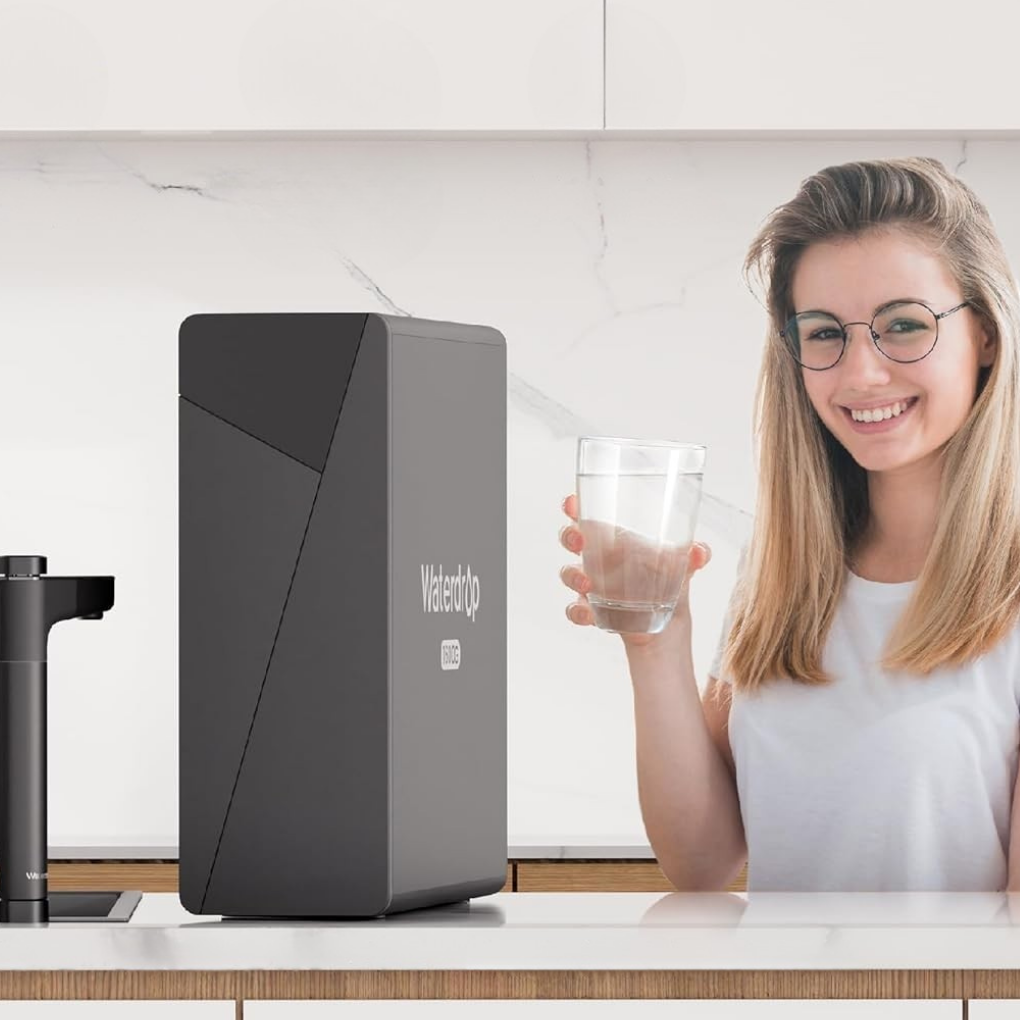
Performance Analysis: 7-stage filtration system removes 99% of 1000+ contaminants including PFAS, heavy metals, and microplastics. Advanced remineralization stage restores beneficial minerals while maintaining slight alkalinity for improved taste and nutrient absorption.
Setup and Maintenance: Under-sink tankless installation requiring 1-2 hours and electrical connection. Tool-free filter replacement with twist-lock design. Filter life monitoring via smart faucet display. Annual filter cost approximately $200-250.
Efficiency Ratio: Superior 3:1 pure-to-waste ratio saves significant water compared to traditional systems. 1600 GPD capacity meets demands of large families or offices.
Filtration Rate: Industry-leading 1600 GPD with 2.3-second cup fill time. Instantaneous flow eliminates waiting periods during peak usage.
Tankless Unit Advantages: The absence of a storage tank eliminates concerns about bacterial growth and secondary contamination. Its space-saving design fits compact under-sink areas.
- Certifications: NSF certified with Red Dot Award 2024 for design excellence.
- User Feedback: Users appreciate the rapid flow rates and premium build quality. The bright display provides clear information on filter status. Some mention the higher upfront cost but note the long-term value and performance.
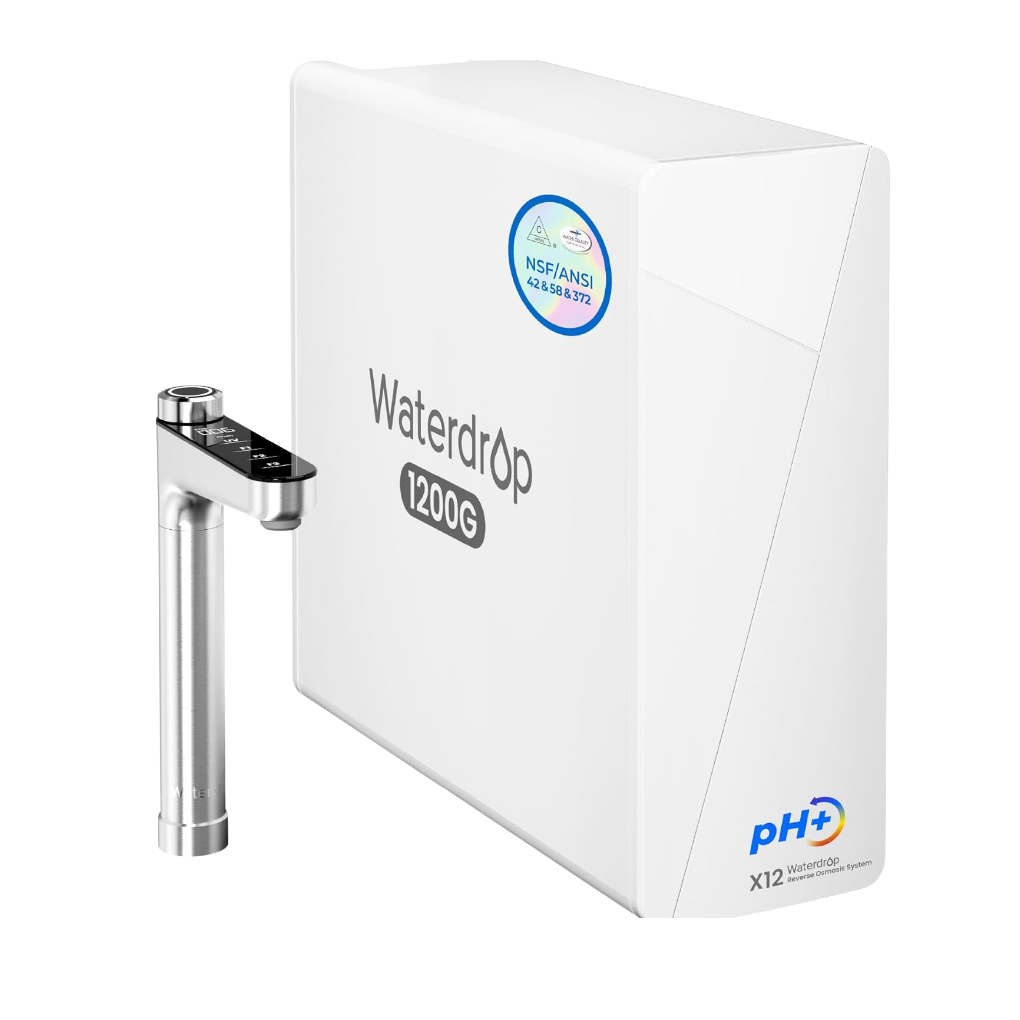
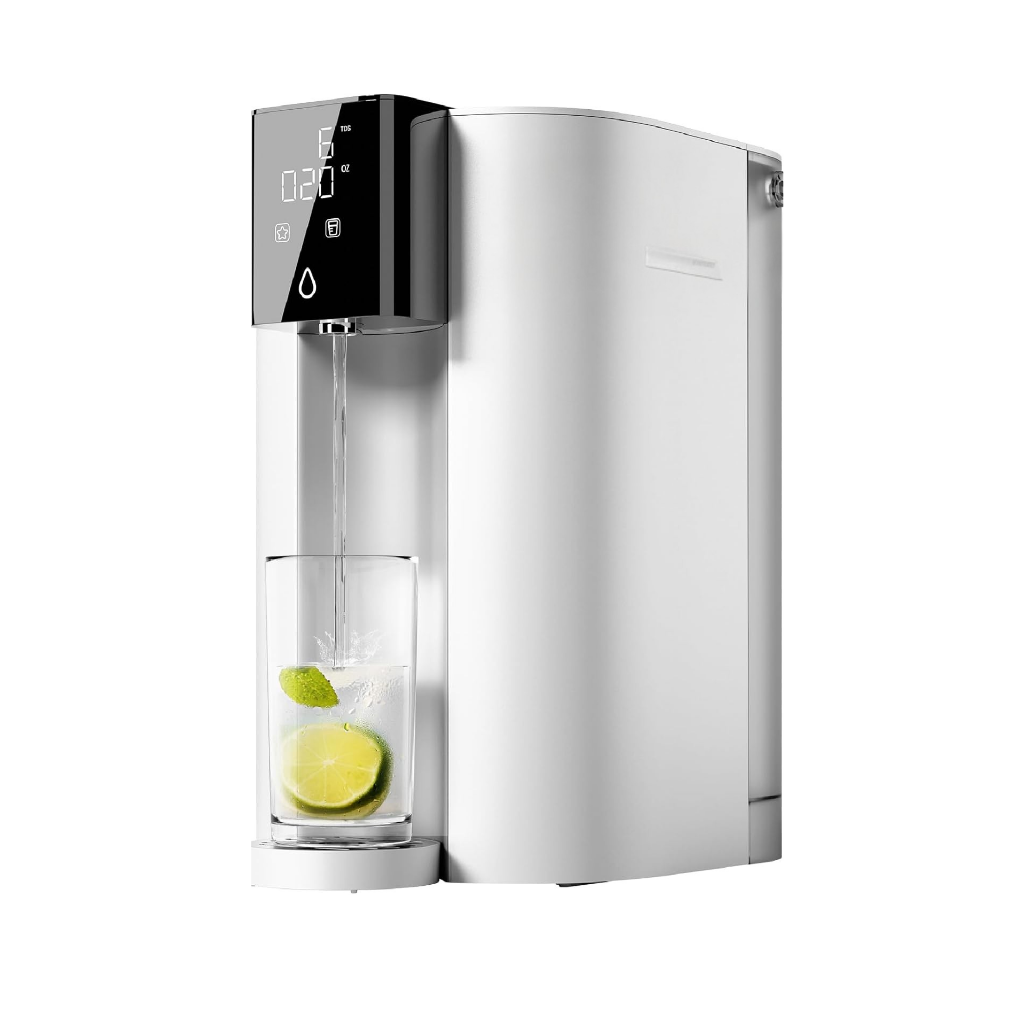

Best Under-Sink Budget Performance: APEC Water ROES-50
$200
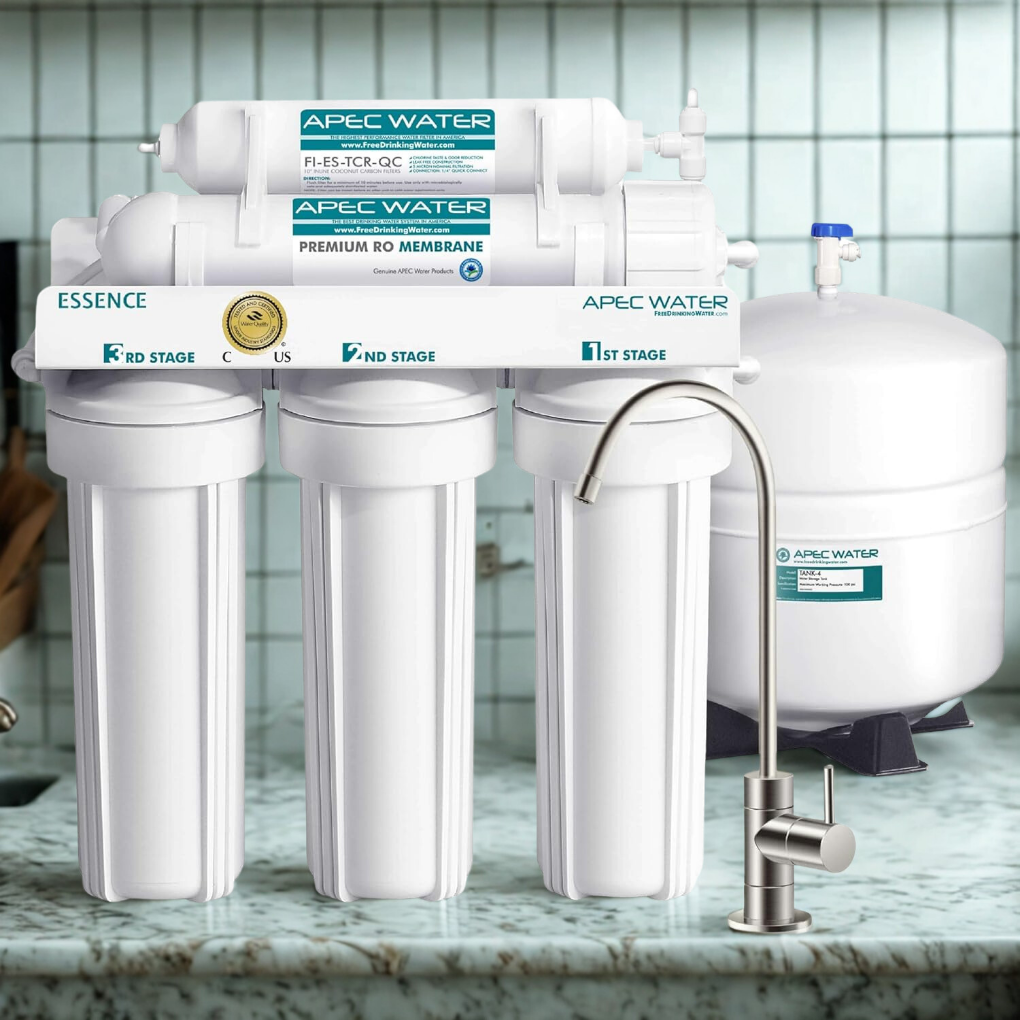
Performance Analysis: Five-stage filtration removes 99% of 48 critical contaminants including chloramines, chlorine, fluoride, lead, pesticides, pharmaceuticals, and PFOA/PFOS. WQA certified to NSF/ANSI Standard 58 for verified performance.
Setup and Maintenance: Traditional under-sink installation requiring 1-2 hours and basic plumbing connections. 50-gallon storage tank provides consistent flow rates. Filter replacement every 6-12 months for pre-filters, 24-36 months for RO membrane.
Efficiency Ratio: Standard 4:1 pure-to-waste ratio typical for tank-based systems in this price range.
Storage Capacity: 50-gallon pressurized tank ensures immediate water availability and consistent flow rates during high-demand periods.
- Certifications: WQA Certification – Verifies the system meets NSF/ANSI Standard 58.
- User Feedback: The APEC ROES-50 is praised for its clean-tasting water, reliable 5-stage filtration, and straightforward DIY setup. Reviewers consistently highlight its strong performance, quiet operation, and long-term durability, all without requiring costly maintenance.
Best Whole-House Solution: US Water Systems Defender
$9,695-15,495
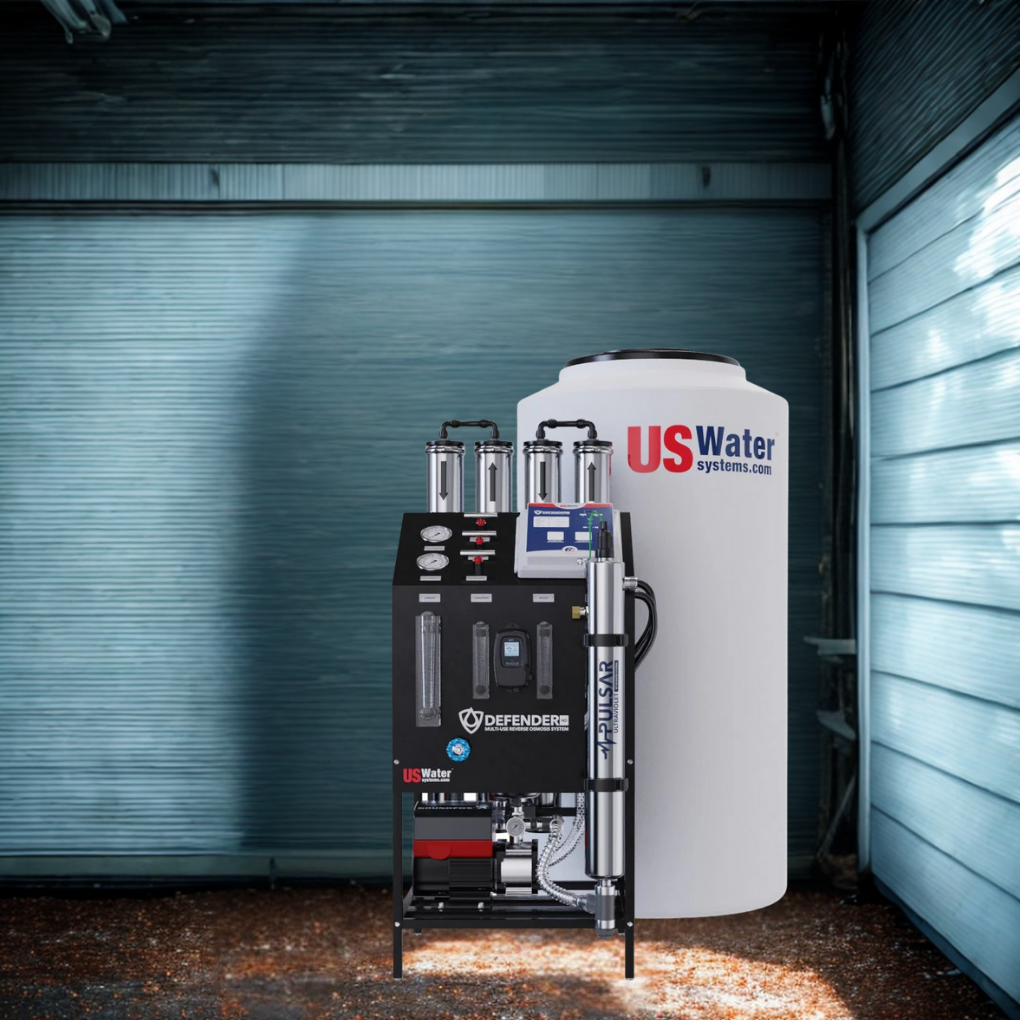
Performance Analysis: Commercial-grade system producing high-capacity filtered water with up to 80% efficiency. Rejects 99% of total dissolved solids while including standard UV disinfection for comprehensive treatment.
Setup and Maintenance: Professional installation required, typically 4-8 hours including system commissioning. Multi-stage stainless steel centrifugal pump provides superior longevity compared to rotary vane pumps used by competitors.
Efficiency Ratio: Exceptional 1.25:1 pure-to-waste ratio (80% efficiency) versus 15% efficiency typical of commercial RO systems. Significant water and cost savings for high-volume applications.
Storage Capacity: 140-250 gallon storage tank options with built-in blending valve for TDS adjustment to user preferences.
Whole-House Coverage: Transforms every faucet in the home with RO-quality water for drinking, cooking, bathing, and laundry applications.
- Certifications: NSF & WQA Certified Components
- User Reviews: Customers generally praise the Defender system for its high-quality components, strong contaminant removal, and Made in USA craftsmanship. Many highlight its ability to deliver clean, great-tasting water throughout the home, with noticeable improvements in skin, hair, and appliance longevity. The system’s customizability, efficient water recovery ratio, and responsive tech support also earn positive mentions.
How to Choose the Right System for Your Home
Start with Your Water Quality
Before you spend a dime on any reverse osmosis system, you need to know what’s actually in your water. I learned this the hard way when I assumed my refrigerator filter was doing enough. Getting your water tested isn’t just helpful, it’s essential for choosing the right system and knowing if it’s working.
Free Testing Options: Many municipalities publish annual water quality reports online. Search “[your city] water quality report” to see what contaminants are detected in your area. While these reports show what leaves the treatment plant, they don’t account for what your pipes might add along the way.
Professional Testing: For $75-300, companies like SimpleLab’s TapScore or Cyclopure offer comprehensive mail-in testing. I’d especially recommend this if you have well water, old plumbing, or live in an area with known contamination issues. The investment pays off when you can target specific problems rather than guessing.
Understanding Your TDS Reading: Total Dissolved Solids (TDS) gives you a baseline number to track your system’s performance. The 240 TDS measurement is moderate, which varies significantly depending on your location and water source. Well water can range from 100 to over 1000 TDS, depending on your geology. Higher TDS doesn’t always mean it’s dangerous, but it indicates how hard your RO system will work.
Red Flags to Watch For: If your test shows high levels of PFAS (over 70 ppt), lead (over 15 ppb), or arsenic (over 10 ppb), an RO system moves from “nice to have” to “essential.” These contaminants can’t be removed with basic carbon filters. Here are two at-home tests you can use. This one by Tap Score is a comprehensive send-away test kit. The second one by Safe Home is highly accurate, but it is harder to read.
Consider Your Household Needs
Daily Water Usage: Think realistically about how much filtered water your family uses. A single person might need 1-2 gallons daily for drinking and cooking, while a family of four easily uses 4-6 gallons. If you’re filling water bottles for the gym, making coffee, cooking pasta, or giving filtered water to pets, your usage adds up quickly.
Space Constraints: Measure your under-sink cabinet before falling in love with any system. You need at least 15 inches wide and 16 inches tall for most under-sink units, plus room for the tank. If you’re in an apartment or have a packed cabinet, countertop systems like my AquaTru might be your only realistic option.
Water Pressure Requirements: Most under-sink RO systems need 40-60 PSI to work properly. You can test this with a simple pressure gauge (about $10 at hardware stores). If your pressure is low, you’ll need a system with a built-in booster pump, which adds to the cost but ensures proper filtration.
Electrical Access: Tankless systems and those with UV sterilization need electrical outlets near your installation point. This isn’t a deal-breaker, but it’s another factor to consider during planning.
How Much Maintenance Do Reverse Osmosis Systems Require?
Maintenance is minimal but essential. You’ll need to replace filters regularly and sanitize the system annually. Most systems come with a one-year warranty and feature a leakproof design for reliable operation.
- Maintenance Requirements: Filter replacement schedules vary significantly based on your water quality, usage patterns, and local conditions. Rather than relying solely on manufacturer timelines, monitor your system’s performance and water quality to determine the optimal replacement intervals. Systems with built-in monitoring features can help eliminate the guesswork associated with determining the optimal maintenance timing.
- What to Expect: All filtration systems require regular maintenance and may experience occasional issues, such as slow flow rates with new filters, minor leaks at connection points, or the need for system flushing after maintenance. These are normal aspects of ownership rather than system defects.
- Getting Started: Every system has its own characteristics and optimal maintenance routine. Plan for a learning period as you become familiar with your specific unit’s performance patterns and maintenance needs.
Important Note: Before purchasing, check with your chosen manufacturer for detailed installation requirements, maintenance schedules, and warranty terms specific to your model and local water conditions.
FAQs About Best Reverse Osmosis System
Yes — a whole-house RO system can slightly raise your water bill because it uses more water to flush contaminants. Most systems waste 2 to 5 gallons for every gallon filtered, though newer, high-efficiency models are much better. If your main goal is cleaner drinking and cooking water, a countertop or under-sink system may be a smarter, more efficient choice.
Absolutely. Many under-sink RO systems include a connection kit for your fridge or ice maker. Just make sure your water pressure is high enough and the tubing is compatible. Once it’s connected, you’ll notice more transparent ice cubes and better-tasting chilled water, free of chlorine and off-flavors from
Before buying, check how often the filters need to be replaced and how much they cost. Some systems use proprietary filters that can be pricey or hard to find. Aim for brands with easy-to-find replacements and transparent pricing. Over five years, filters usually cost between $100–$300 total, which is still cheaper than bottled water.
Most RO systems last 10–15 years with regular maintenance. The filters and membrane need to be changed every 6–24 months, depending on your water quality, but the main housing and faucet can last well over a decade. Keeping up with filter changes helps protect the membrane and extend your system’s life.
Yes — especially for countertop or plug-and-play systems. Under-sink units take about one to three hours to install with basic tools, while a professional should handle whole-house systems. If you can connect a faucet and use a wrench, you can likely install an under-sink RO system on your own.
This Has Been About Finding the Best Reverse Osmosis System
After months of drinking reverse osmosis water, I’m convinced it’s one of the best investments you can make for your family’s health. Yes, there’s an upfront cost and ongoing filter replacements. Still, when I think about the PFAS, microplastics, and pharmaceuticals I was potentially consuming before, the peace of mind is worth it.
Get your water tested first; you might be surprised what’s actually in there. Once you see what’s coming out of your tap, choosing the right RO system becomes an easy decision. The taste difference alone will convince you it was the right choice.
Featured image is from Amazon.
📚 References
- Consumer Reports. (2025, January). How to get PFAS out of your drinking water. Consumer Reports. https://www.consumerreports.org/water-contamination/how-to-get-pfas-out-of-your-drinking-water-a7303943293/
- National Sanitation Foundation. (2024, February 15). Forever chemicals: Advancement of filtration standards. NSF. https://www.nsf.org/knowledge-library/forever-chemicals-advancement-filtration-standards
- Orb Media. (2017). Invisibles: The plastic inside us – A global investigation. Orb Media. https://orbmedia.org/invisibles-final-rep
- U.S. Environmental Protection Agency. (2024, November 20). Identifying drinking water filters certified to reduce PFAS. EPA Water Research. https://www.epa.gov/water-research/identifying-drinking-water-filters-certified-reduce-pfas
